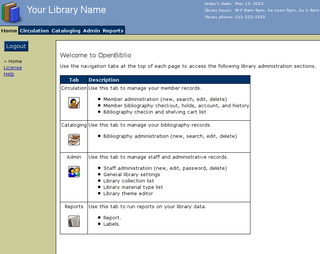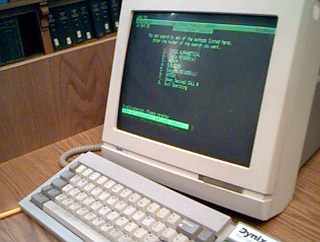
A library catalog is a register of all bibliographic items found in a library or group of libraries, such as a network of libraries at several locations. A catalog for a group of libraries is also called a union catalog. A bibliographic item can be any information entity that is considered library material, or a group of library materials, or linked from the catalog as far as it is relevant to the catalog and to the users (patrons) of the library.

BibTeX is reference management software for formatting lists of references. The BibTeX tool is typically used together with the LaTeX document preparation system. Within the typesetting system, its name is styled as . The name is a portmanteau of the word bibliography and the name of the TeX typesetting software.
This page is a glossary of library and information science.
A discovery system is a bibliographic search system based on search engine technology. It is part of the concept of Library 2.0 and is intended to supplement or even replace the existing OPAC catalogs. These systems emerged in the late 2000s in response to user desire for a more convenient search option similar to that of internet search engine. The results from searching a discovery system may include books and other print materials from the library's catalog, electronic resources such as e-journals or videos, and items stored in other libraries.
The online public access catalog (OPAC), now frequently synonymous with library catalog, is an online database of materials held by a library or group of libraries. Online catalogs have largely replaced the analog card catalogs previously used in libraries.

An integrated library system (ILS), also known as a library management system (LMS), is an enterprise resource planning system for a library, used to track items owned, orders made, bills paid, and patrons who have borrowed.

Koha is an open source integrated library system (ILS), used world-wide by public, school and special libraries. The name comes from a Māori term for a gift or donation.
The University of Tokyo Library in Tokyo, Japan, consists of the General Library, the Komaba Library, and the Kashiwa Library.
LibraryThing is a social cataloging web application for storing and sharing book catalogs and various types of book metadata. It is used by authors, individuals, libraries, and publishers.
Serials Solutions was a division of ProQuest that provided e-resource access and management services (ERAMS) to libraries. These products enabled librarians to more easily manage electronic resources that serve the needs of their users. Serials Solutions became part of ProQuest Workflow Solutions in 2011 and the "Serials Solutions" name was retired in 2014. In 2015, Proquest acquired Ex Libris Group, a library automation company with many similar products to those of ProQuest Workflow Solutions. The Workflow Solutions division was to be merged with Ex Libris into a new business group called Ex Libris, a ProQuest Company.

VTLS Inc. was a global company that provided library automation software and services to a diverse customer base of more than 1900 libraries in 44 countries. The for-profit company was founded in 1985 by Dr. Vinod Chachra, who became the President and CEO of the company. VTLS originated as "Virginia Tech Library Systems", an automated circulation and cataloging system created for Virginia Tech’s Newman Library in 1975. In addition to its headquarters in Blacksburg, Virginia, United States, VTLS had five international offices in Australia, Brazil, India, Malaysia and Spain. VTLS was one of the few ISO 9001:2008 quality-certified companies within the library industry for many years. The company was acquired by Innovative Interfaces in 2014.
Evergreen is an open-source integrated library system (ILS), initially developed by the Georgia Public Library Service for Public Information Network for Electronic Services (PINES), a statewide resource-sharing consortium with over 270 member libraries.

PMB is a fully featured open source integrated library system. It is continuously developed and maintained by the French company PMB Services.

BibDesk is an open-source reference management software package for macOS, used to manage bibliographies and references when writing essays and articles. It can also be used to organize and maintain a library of documents in PDF format and other formats. It is primarily a BibTeX front-end for use with LaTeX, but also offers external bibliographic database connectivity for importing, a variety of means for exporting, and capability for linking to local documents and automatically filing local documents. It takes advantage of many macOS features such as AppleScript and Spotlight.

NewGenLib is an integrated library management system developed by Verus Solutions Pvt Ltd. Domain expertise is provided by Kesavan Institute of Information and Knowledge Management in Hyderabad, India. NewGenLib version 1.0 was released in March 2005. On 9 January 2008, NewGenLib was declared free and open-source under GNU GPL. The latest version of NewGenLib is 3.1.1 released on 16 April 2015. Many libraries across the globe are using NewGenLib as their Primary integrated library management system as seen form the NewGenlib discussion forum.
An inventory is the one method that libraries and archives use to determine whether some items in their collection are in need of preservation or conservation activities. A modern inventory might involve examining item by item with a barcode scanner and a laptop, with the objective of adjusting bibliographic and item records in theirs and OCLC's WorldCat databases. Using a laptop and handheld bar code reader will "reduce human error and inconsistencies, while helping to maintain staff concentration and enthusiasm for the project".

OpenBiblio is an open source Integrated Library System. The software is popular with small and rural libraries worldwide due to its simplicity, extensive language support, and good documentation.

The Dynix Automated Library System was a popular integrated library system, with a heyday from the mid-1980s to the late-1990s. It was used by libraries to replace the paper-based card catalog, and track lending of materials from the library to patrons.
A library website provides a library with a website to offer its services and to tell its story to its community.
Brocade Library Services is a web-based library information management System developed by the University of Antwerp (UAntwerp) in 1998. Since 2000 the development has been in cooperation with the governmental ICT Agency Cipal Schaubroeck.









